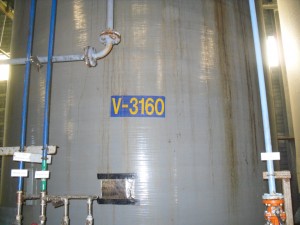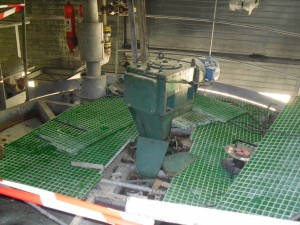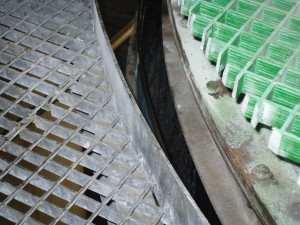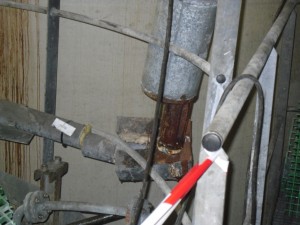In the purification workshop of an aspartame production facility, a fireless explosion occurred at 2:05 p.m. while a subcontractor was performing arc welding work above a tank containing a mixture of 20 m³ of an aqueous solution (42% water) of hydrochloric acid, methanol and aspartame. The plant had been shut down for 1.5 months, and the welding operation took place as part of maintenance work to replace the steel gratings on the roof of the tank with more corrosion-resistant plastic grating elements.
The subcontractor was thrown to the ground by the blast from the explosion. He was taken to the hospital suffering from 2 broken vertebrae. The building’s fire alarm had been tripped, so the facility operator alerted the emergency services, initiated the internal safety plan, and evacuated the building. About fifty firefighters sprayed down the area to cool down the tank. The dome covering the tank had shifted 10 cm after being lifted by the explosion, leaving the liquid phase exposed to the open air. Because the results of the explosimetry and toximetry measurements were normal (no HCl leakage and no explosive atmosphere), the facility operator lifted its internal safety plan at 4:15 p.m. A press release was issued. The following morning, the contents of the tank in question were pumped over to another tank.
The accident did not generate any leaks or environmental consequences. The equipment associated with the tank was damaged (mixer, pipes), but the tank was not ruptured.
The Inspection authorities for classified facilities, which had come to the site that very day, prohibited the facility from restarting before an accident report had been submitted and corrective measures implemented.
The facility operator decided to interrupt all work in the tank area. All hot-spot operation in the purification building was subject to an atmosphere measurement before the start of operations and a follow-up measurement with an explosimeter during the course of the work.
The tank (50 m³, made of resin, in place since the site was built in 1993) was maintained at 16 °C by means of a glycol coil. The tank’s vapour space suction system and the HCl scrubber had not been operating since the site was shut down in late July, although the tank still contained 20 m³ of a mixture containing hydrochloric acid (2.45 mol/l) and methanol (4.4 g/l). The composition and quantity of the mixture had not changed since late July. Despite the cooling, a sufficient quantity of methanol vapours may have formed to reach the LEL (lower explosive limit) and may have been ignited by the heat input from the welding station. The facility operator disproved this hypothesis by providing a design note indicating that the methanol content in the vapour space was lower than the LEL of the methanol. To reach the LEL, with the same mixture composition and at atmospheric pressure, the mixture would have had to have been increased to 50 °C. An assessment by an external body was carried out. The subcontractor had a work permit and a fire permit but which did not mention the presence of acid in the tank. The area had not been classified as a zone with an explosive atmosphere.







